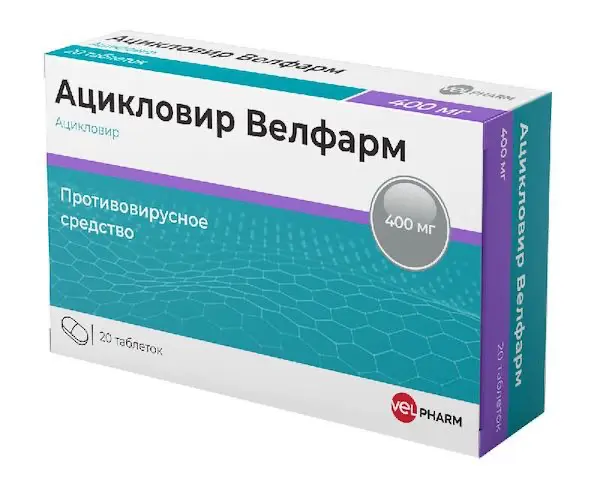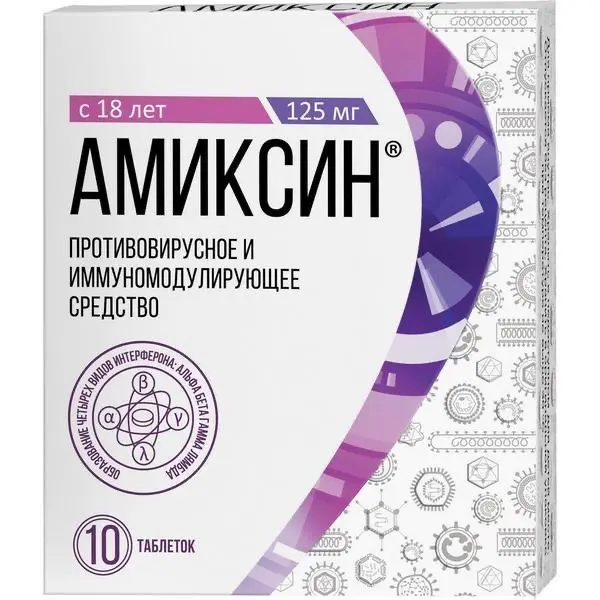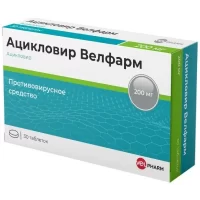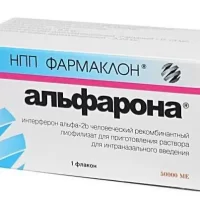Description
AcyclovirWelfarm Pharmacodynamics
Mechanism of action
Acyclovir is a synthetic analog of purine nucleoside, which has the ability to inhibit in vitro and in vivo human herpes viruses, including herpes simplex virus (HPV) types 1 and 2, varicella zoster virus (Varicella zoster virus (VZV)), Epstein-Barr virus (EBV) and cytomegalovirus (CMV). In cell culture, acyclovir has the most pronounced antiviral activity against HPV-1, followed in descending order of activity by HPV-2, VZV, EBV and CMV.
The inhibitory effect of acyclovir against herpes viruses (HAV-1, HAV-2, VZV, EBV and CMV) is highly selective. Acyclovir is not a substrate for thymidine kinase enzyme of uninfected cells, so acyclovir is low toxic for mammalian cells. However, thymidinkinase of cells infected with HPV, EVD, EBV and CMV converts acyclovir into acyclovir monophosphate, a nucleoside analog, which is then sequentially converted into diphosphate and triphosphate under the action of cellular enzymes. Incorporation of acyclovir triphosphate into the viral DNA chain and subsequent breaking of the chain blocks further replication of viral DNA.
In patients with severe immunodeficiency, prolonged or repeated courses of acyclovir therapy may lead to the emergence of resistant strains, so further treatment with acyclovir may not be effective. Most acyclovir-resistant strains isolated have relatively low levels of viral thymidine kinase as well as disorders of viral thymidine kinase or DNA polymerase structure. In vitro exposure of herpes simplex virus (HPV) strains to acyclovir can also lead to the formation of less sensitive strains. No correlation has been established between the sensitivity of herpes simplex virus (HPV) strains to acyclovir in vitro and the clinical efficacy of the drug.
Indications
– Treatment of skin and mucous membrane infections caused by herpes simplex virus, including primary and recurrent genital herpes;
– Prevention of recurrent herpes simplex virus infections in patients with normal immune status;
– prevention of herpes simplex virus infections in immunodeficient patients;
– treatment of varicella and herpes zoster (early treatment of herpes zoster with acyclovir has an analgesic effect and may reduce the incidence of post-herpetic neuralgia).
Contraindications
– Hypersensitivity to acyclovir or valacyclovir or any other component of the drug;
– Lactose intolerance, lactase deficiency, glucose-galactose malabsorption;
– Children under 3 years of age.
Caution
Pregnancy, breast-feeding, old age, renal insufficiency, dehydration, concomitant use with other nephrotoxic drugs.
Usage during pregnancy and breast-feeding.
Fertility
No data are available on the effect of acyclovir on female fertility.
In a study involving 20 male patients with normal sperm counts, it was found that acyclovir oral administration at a dose of up to 1 g per day for 6 months had no clinically significant effect on sperm count, motility or morphology.
Pregnancy
A post-registration pregnancy registry collected data on pregnancy outcomes in women treated with acyclovir in different dosage forms. When analyzing the registry data, there was no increase in the number of birth defects in infants whose mothers took acyclovir during pregnancy, as compared to the general population. The birth defects detected were not characterized by uniformity or a pattern suggesting a common cause.
However, caution should be exercised when prescribing the drug to women during pregnancy and the anticipated benefit to the mother and possible risk to the fetus should be evaluated.
Breastfeeding period
After oral administration of acyclovir at a dose of 200 mg 5 times daily, acyclovir was detected in breast milk at concentrations ranging from 60% to 410% of the plasma concentration. At these concentrations in breast milk, breastfed infants may receive acyclovir up to 0.3 mg/kg/day. In view of this, caution should be exercised when prescribing the drug to breastfeeding women.
Dosage and administration
- The drug can be taken with food, because food intake does not interfere with its absorption to a significant extent. The tablets should be taken with a full glass of water.
- Adults
Treatment of infections caused by the herpes simplex virus
For the treatment of infections caused by herpes simplex virus, the recommended dose of acyclovir is 200 mg orally five times a day (every four hours except for bedtime). The course of treatment is 5 days, but may be prolonged for severe primary infections. - In cases of severe immunodeficiency (e.g., after bone marrow transplantation) or if intestinal absorption is impaired, the dose may be increased to 400 mg. Alternatively, the use of acyclovir in a lyophilisate form for preparation of a solution for infusion may be considered.
- Treatment should be started as early as possible after the onset of infection; for relapses, treatment should be given as early as the prodromal period or when the first rash elements are present.
- Prevention of recurrent herpes simplex virus infections in patients with normal immune status
- For prevention of recurrence of infections caused by herpes simplex virus in patients with normal immune status, the recommended dose is 200 mg orally four times a day (every 6 hours).
- Many patients find the more convenient therapy regimen of 400 mg orally two times a day (every 12 hours) suitable.
- In some cases, lower doses of 200 mg orally 3 times daily (every 8 hours) or 200 mg orally 2 times daily (every 12 hours) are effective.
Some patients may experience an exacerbation of the infection when taking a total daily dose of 800 mg. - Treatment with acyclovir should be interrupted periodically for 6-12 months to detect possible changes in the course of the disease.
- Prevention of infections caused by herpes simplex virus in immunodeficient patients
For prophylaxis of infections caused by herpes simplex virus in immunodeficiency patients, the recommended dose is 200 mg orally 4 times a day (every 6 hours).
In cases of severe immunodeficiency (e.g., after bone marrow transplantation) or if intestinal absorption is impaired, the dose may be increased to 400 mg orally. Alternatively, the possibility of using acyclovir in the dosage form lyophilisate for preparation of a solution for infusion may be considered. - The duration of prophylactic therapy is determined by the duration of the period during which there is a risk of infection.
Treatment of chickenpox and herpes zoster - For treatment of chicken pox and herpes zoster the recommended dose is 800 mg orally five times a day (every four hours except for bedtime). The course of treatment is 7 days.
Treatment of herpes zoster should be started as soon as possible from the first symptoms of the disease, because the treatment will be more effective.
Treatment of chickenpox in patients with normal immune status should be started within 24 hours of the onset of the rash. - In patients with severe immunodeficiency (e.g. after bone marrow transplantation) or with impaired intestinal absorption, the possibility of prescribing acyclovir as a lyophilisate for preparation of a solution for infusion should be considered.
Special patient groups - Children 3 years of age and older
Treatment of infections caused by herpes simplex virus; prophylaxis of infections caused by herpes simplex virus in immunodeficient patients
Ages 3 years and older – same doses as for adults. - Treatment of chicken pox
Age 6 years and older – 800 mg orally 4 times a day.
Ages 3 to 6 years old – 400 mg orally 4 times a day. - A more precise dosage can be determined at the rate of 20 mg/kg of body weight (but no more than 800 mg) orally 4 times a day. The course of treatment is 5 days.
In the treatment of chicken pox and herpes zoster, the recommended doses of the drug are:
– if creatinine clearance is less than 10 ml/min – 800 mg orally 2 times a day (every 12 hours);
– if creatinine clearance is 10-25 ml/min – 800 mg orally 3 times a day (every 8 hours).





